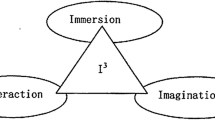Abstract
In the process of rapid development, multiple changes and innovative breakthroughs in the information age, people's thinking mode and aesthetic taste are also constantly changing and expanding. The traditional two-dimensional form of graphic design has been unable to meet the actual needs of the public and the designer's design concept. Multidimensional graphic design is recognized to be the new field, its application is very wide, and its aesthetic form will have a novel generation with the extension of time and the renewal and development of disciplines. Multidimensional graphic design can be initially set as the design of various spatial forms in 2D plane and the design of static solid interface in 3D environment. The research of graphic design under multi-dimensional vision is still in constant exploration. Its openness, dissociation and fuzziness determine that we can only study it in constant changes. Therefore, this paper summarizes the voice perception model and Internet of Things related technology, and constructs a multidimensional graphic design aesthetic evaluation system. The model is initially designed based on the voice signal processing framework and then, the IoT system is combined for the implementations. The proposed model is verified through the simulations, its performance is validated.










Similar content being viewed by others
References
Alzubi OA, Alzubi JA, Dorgham O, Alsayyed M (2020) Cryptosystem design based on hermitian curves for IoT security. J Supercomput. https://doi.org/10.1007/s11227-020-03144-x
Arnheim R (2008) Art and visual perception. Hunan Fine Arts Publishing House
Chen L, Xinghong J, Gang D (2011) Technical characteristics of Internet of things and its wide application. Sci Consult 9:86–86
Dai Y, Jia X (2010) Space and material. Shanghai People's fine Arts Publishing House
Gheisari M, Najafabadi HE, Alzubi JA, Gao J, Wang G, Abbasi AA, Castiglione A (2021) OBPP: an ontology-based framework for privacy-preserving in IoT-based smart city. Future Gener Comput Syst. https://doi.org/10.1016/j.future.2021.01.028
Gheisari M, Panwar D, Tomar P, Harsh H, Zhang X, Solanki A, Nayyar A, Alzubi JA (2019) An optimization model for software quality prediction with case study analysis using MATLAB. IEEE Access 7:12–28
Guenther FH, Ghosh SS, Tourville A (2006) Neural modeling and imaging of the cortical interactions underlying syllable production. Brain Lang 96:280–301
Huang J (2016) Overview of internet of things. J Beijing Vocat Coll Finance Trade 6:25–43
Jafar. A. Alzubi, "Blockchain-based Lamport Merkle Digital Signature: Authentication tool in IoT healthcare" Computer Communications, Vol. 170, pp 200–208, 2021.
Jia Y (2010) Research on the application of Internet of things technology in environmental monitoring and early warning. Shanghai Constr Technol 6:65–67
Khan LU, Saad W, Han Z, Hossain E, Hong CS (2021) Federated learning for internet of things: recent advances, taxonomy, and open challenges. IEEE Commun Surv Tutor 12:19–28
Kuhl PK (1991) Human adults and human infants show a perceptual magnet effect for the prototypes of speech categories, monkeys do not. Percept Psychophys 50(2):93–107
Mei P (2015) Dimension expansion and its application in graphic design. Popul Lit Art 4:104–105
Miller JD (1989) Auditory-perceptual interpretation of the vowel. J Acoust Soc Am 85(5):2114–2134
Mohammad N, Pouriyeh S, Parizi RM, Dorodchi M, Valero M, Arabnia HR (2020) Internet of Things for current COVID-19 and future pandemics: an exploratory study. J Healthc Inform Res 8:1–40
Nauman A, Qadri YA, Amjad M, Zikria YB, Afzal MK, Kim SW (2020) Multimedia internet of things: a comprehensive survey. IEEE Access 8:8202–8250
Rajkumar PV, Sandhu R (2016a) Safety decidability for pre-authorization usage control with finite attribute domains. IEEE Trans Dependable Secure Comput 13(5):582–590
Rajkumar PV, Sandhu R (2020) Safety decidability for pre-authorization usage control with identifier attribute domains. IEEE Trans Dependable Secure Comput 17(3):465–478
Rajkumar PV, Ghosh SK, Dasgupta P (2010) Concurrent usage control implementation verification using the spin model checker. In: international conference on network security and applications, pp 214–223
Rajkumar PV, Sandhu R (2016) Poster: security enhanced administrative role based access control models. In: ACM conference on computer and communications security, Vienna, Austria, 2016
Sadeeq MAM, Subhi Z (2021) Energy management for internet of things via distributed systems. J Appl Sci Technol Trends 2(02):59–71
Salam A (2020a) Internet of things for environmental sustainability and climate change. In: Internet of things for sustainable community development. Springer, Cham, pp 33–69
Salam A (2020b) Internet of things for sustainable community development: introduction and overview. In: Internet of things for sustainable community development. Springer, Cham, pp 1–31
Smys S, Basar A, Wang H (2020) Hybrid intrusion detection system for internet of Things (IoT). J ISMAC 2(04):190–199
Tran-Dang H, Krommenacker N, Charpentier P, Kim D-S (2020) Toward the internet of things for physical internet: perspectives and challenges. IEEE Internet Things J 7(6):4711–4736
Wang S, Gang P (2007) Language, speech and technology. Hong Kong: City University of Hong Kong Press, pp 30–50
Zhang S, Huang W, Wang H (2020) Crop disease monitoring and recognizing system by soft computing and image processing models. Multimed Tools Appl 79(41):30905–30916
Zhang Y, Li Y, Wang H (2021) Mobile neural intelligent information system based on edge computing with interactive data. Neural Comput Appl 33(9):4329–4341
Zielonka A, Sikora A, Woźniak M, Wei W, Ke Q, Bai Z (2020) Intelligent internet of things system for smart home optimal convection. IEEE Trans Industr Inf 17(6):4308–4317
Funding
No funding has been availed for this work.
Author information
Authors and Affiliations
Corresponding author
Ethics declarations
Conflict of interest
The authors declare that they have no conflict of interest.
Human and animals rights
Research involving Human Participants and/or Animals. This section is not applicable on this study.
Additional information
Publisher's Note
Springer Nature remains neutral with regard to jurisdictional claims in published maps and institutional affiliations.
Rights and permissions
About this article
Cite this article
Wang, Z. Aesthetic evaluation of multidimensional graphic design based on voice perception model and internet of things. Int J Syst Assur Eng Manag 13, 1485–1496 (2022). https://doi.org/10.1007/s13198-021-01492-2
Received:
Revised:
Accepted:
Published:
Issue Date:
DOI: https://doi.org/10.1007/s13198-021-01492-2




